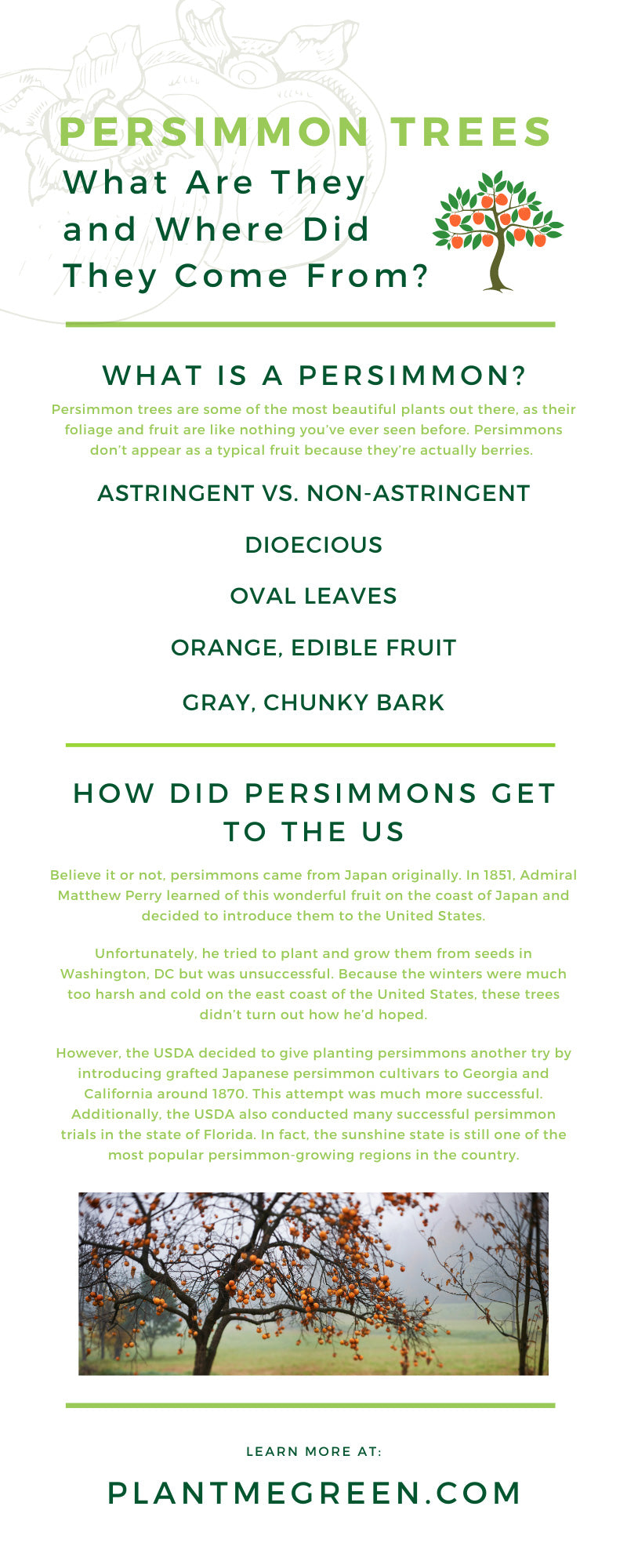Persimmon Trees: What Are They and Where Did They Come From?
Almost everyone knows that fruit is a significant part of their daily diet, but some fruits are much more available and popular than others. For instance, it’s not uncommon for someone to say they’re craving an apple or an orange. On the other hand, it’s rare to hear anyone talk about persimmons and all of their wonder. Whether you love this fantastic fruit or you’ve never heard of it, follow along to learn more about persimmon trees, what they are, and where they came from.
What Is a Persimmon?
Persimmon trees are some of the most beautiful plants out there, as their foliage and fruit are like nothing you’ve ever seen before. Many people would know an apple, pear, or crabapple tree if they saw one; however, most people in the US haven’t seen a persimmon tree. Persimmons don’t appear as a typical fruit because they’re actually berries. If you see these unique fruits on their tree, you may think they’re tomatoes.
With that said, persimmons aren’t tomatoes, and they don’t have a similar flavor. Here are a few intriguing characteristics of a typical persimmon tree.
Astringent vs. Non-Astringent
There is more than one type of persimmon fruit, and all varieties fall into two categories: astringent and non-astringent. Astringent persimmons are best when you allow them to ripen for a few days after removing them from the tree. They should feel soft when you eat them, and this type is the sweetest. On the other hand, you can eat non-astringent persimmons directly from the tree. These aren’t as sweet as the others, and they’re more hard and crunchy, like an apple.
While these persimmon types are very different, they have unique but valuable characteristics. Trying both types is the best way to determine your favorite.
Dioecious
Interestingly, persimmon trees are dioecious, meaning that the male and female flowers grow on separate trees rather than the same. However, these gorgeous trees may have a few perfect flowers containing both male and female reproductive organs. The male flowers are pink in color, while female flowers are usually white or cream in color.
Oval Leaves
Even though many different trees have oval leaves, you should know that persimmon trees have vibrant, green, oval leaves in the spring and summer months. During the fall, these green leaves will turn shades of red and purple for a beautiful and unique change of scenery.
Orange, Edible Fruit
The main character of persimmon trees is the fruit itself. These gorgeous fruits range from an inch to 3½ inches in size and are a vibrant orange color. Many people describe their appearance and texture as a typical tomato; however, their flavor is much sweeter than that familiar fruit. Interestingly, these tasty fruits are very popular for eating fresh, in baked goods, jams, and more, making them a valuable addition to your property.
Gray, Chunky Bark
Tree bark is one of the most telling features of different varieties, and persimmon tree bark is no exception. Intriguingly, this bark is usually medium to dark gray in color with a blocky, chunky texture and appearance. Furthermore, it’s not uncommon to see an orange tinge coming through the cracks in the bark of a persimmon tree.
How Did Persimmons Get to the US
Believe it or not, persimmons came from Japan originally. In 1851, Admiral Matthew Perry learned of this wonderful fruit on the coast of Japan and decided to introduce them to the United States. Unfortunately, he tried to plant and grow them from seeds in Washington, DC but was unsuccessful. Because the winters were much too harsh and cold on the east coast of the United States, these trees didn’t turn out how he’d hoped.
However, the USDA decided to give planting persimmons another try by introducing grafted Japanese persimmon cultivars to Georgia and California around 1870. This attempt was much more successful. Additionally, the USDA also conducted many successful persimmon trials in the state of Florida. In fact, the sunshine state is still one of the most popular persimmon-growing regions in the country.
Caring for Persimmon Trees
Persimmon trees are relatively tolerant to most soil conditions and may even tolerate clay or dry soil types; however, they prefer slightly acidic soil. In addition, these fruit trees are drought-tolerant after maturity, making them mostly low-maintenance additions to your property. However, they require well-drained soil to prevent various unwanted pests and diseases.
Even though these trees are resilient in droughts, you should consider adding a significant amount of water to the soil around them when you can. Aside from watering, there isn’t much you need to do to maintain happy, healthy persimmon trees.
If you want to change the tree’s structure or encourage new growth, consider pruning dead or unhealthy limbs and branches to ensure your tree bears the best fruit. You should prune when the tree is dormant in the late winter or early spring. Once the growing season begins, open wounds increase the threat of illness for your trees.
Fertilizer is essential for most trees, but persimmon trees don’t need it to survive or thrive after maturity. If you want to add fertilizer to your trees, you can apply 10-10-10 fertilizer to the soil in the late winter or early spring. However, fertilizer isn’t entirely necessary if your persimmon tree has a robust root system and bears fruit consistently.
After learning more about persimmon trees, what they are, and where they came from, you may want to add a few to your property. Most people have never had a persimmon, as they’re incredibly fragile. Even if your grocery store has them, they may be expensive or lacking quality, as they typically spoil during transport.
That said, those that grow them in their backyard have the advantage of fresh, delicious persimmon fruit whenever they desire. Eat them fresh, bake them into yummy treats, or turn them into jam; regardless, persimmons are one of the world’s most unique and tasty fruits.



